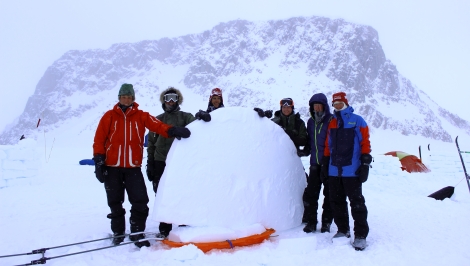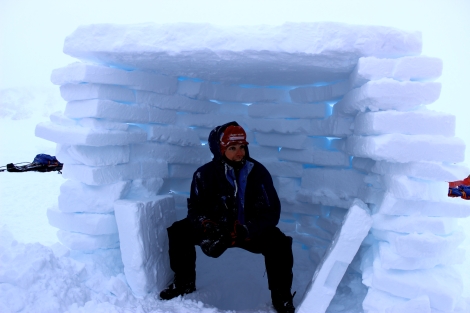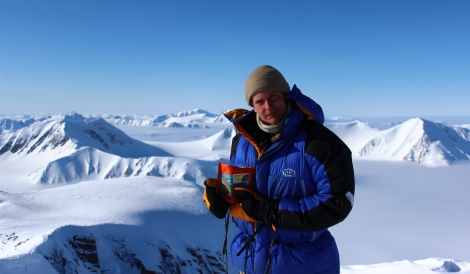After 10 days spent in the field, I have returned to the relative civilisation of the world’s Northernmost town to hear devastating news. The Sex Panther, my heroic leopard-print snow-mobile, is no more. She had been sounding poorly for some time and whilst I was away, matters rather came to a head. Cees was driving her down to work one morning when she began to emit a howling, grinding noise. Throttle fully opened, Cees could not coax the machine faster than 10kmph (why he had tried to fully open the throttle when it was making such a noise is another question). “I held on as long as I could!” she seemed to cry, before the engine exploded. A tragedy, really. Fortunately, a tragedy that has occurred at the very end of the season.

The calm before the storm on Lomonosovfonna
Back in Longyearbyen, the spring thaw is well underway. Like a sticky, newborn-chick extricating itself from an egg, the sight is not pretty. The snow becomes saturated and mixes with the earth to leave puddles of brown slush lying everywhere. Snow mobiles labour over bare roads and muddy patches of ground. The pristine white is adulterated and contaminated, but it is an exciting time. It has been a very long winter and life is returning to these frozen lands. For months, we have only been accompanied by the ptarmigan and its odd, belching call. Now migrating summer birds sing gloriously. I had forgotten how much I missed the sound but it is of extraordinary, soul-deep comfort.
With the birds, the smell has returned. Locked in a freezer for so long, my senses have been deprived of any sight other than white, any sound other than wind and any smell at all. As the world melts, powerful aromas greet your nose like an old friend. The rich smell of vegetation; the mouth-watering scent of a muddy puddle and smell of sun-heated metal now saturate the air. It is quite an experience as reminders of my Southern home reappear on all sides. The one thing that is missing above all though is trees and describing how much I miss them is difficult. A reminder as gentle as the smell of pine when entering a cabin is now enough to make me think on them for hours, imagining the sussuration of the leaves, their swaying motion and the feeling of being enveloped in a forest.
The extremely capable guests I was guiding up Newtontoppen. Nothing if not ambitious, here they are seen holding a single slab of snow destined to become the roof of our luxury Arctic loo
The completed loo in question
The spring thaw is all the more welcome for what preceded it: a ski trip I was guiding (along with an agreeable ragamuffin named Knut) to Svalbard’s highest peak, Newtontoppen (1712m). The route carries us over the vast Lomonosovfonna; an ice-cap that covers central Svalbard. The terrain is sheer, featureless ice; an immense plateau almost a kilometre thick in places and utterly exposed to Svalbard’s brutal weather.
Our first day was calm and sunny, which was as far as our luck held. From the second day, winds flooded across the plateau and locked us in an almost unbroken whiteout. We were battered from every angle, with trails of spindrift collecting behind any raised object and tons of snow being deposited around our tents. At times the winds threatened to tear our tents away and drive us back, as it had already done to the last two expeditions to attempt this journey. In brief breaks in the onslaught, we inched towards our destination, stealing precious miles before being forced to ground again. In all, we spent 4 days locked in the tent, awaiting our chance.
On the climb up Newtontoppen
In the meantime, I read. I had brought with me a book on Antarctic history and sitting in a tent being buffeted by wind and snow, I found the passages concerning Edward Wilson particularly powerful. Wilson, a doctor and naturalist, was one of the party who had died with Captain Scott on his return from the South Pole. Accounts of the expedition make it clear that he was universally admired by its members. Known for the strength of his faith and will, he had written to his sister almost twenty years before his death to say he was fascinated by the idea that a man might transcend selfish desires or the necessity for life and instead become utterly devoted to the service of others. Writing of him some time before their final march together, Scott seems to have thought he was successful in this wish: “Word’s must always fail me when I talk of Wilson. I believe he really is the finest character I ever met.” He describes him as the confidant of every man on the expedition, steely in resolve when pulling a sledge and ever willing to help his comrades.
But to truly test Wilson’s resolve and the idea that he might have achieved spiritual transcendence, he had to face death. Scott witnessed this too and in his journal wrote an account of it to Wilson’s wife, Oriana: “I can do no more to comfort you than to tell you that he died as he lived a brave, true man – the best of comrades and the staunchest of friends.”
Wilson himself also wrote a letter to Oriana in his final hours, the tone of which left me in awe. “We have struggled to the end and have nothing to regret… The Barrier has beaten us though we got to the Pole. My beloved wife, these are small things, life itself is a small thing to me now, but my love for you is for ever… All is well.” For me, in that small tent atop an ice-cap and not having moved for days due to the weather, the circumstances under which he’d written that letter seemed more real than ever before. There were many well-documented heroes and worthy role-models from that expedition. Titus Oates, who had walked to his death in a blizzard to give his companions the chance to escape without him. Scott himself, the tenacious leader of his men who had died last of all, alone in that tent with the bodies of his two stanchest comrades. But Wilson, whose heroism is perhaps less well documented, seems to me the most splendid of them all.

Knut and a guest, Endre, on the final push for the summit
We waited for the weather to break, a chance which at last arrived on the 2nd of May. The forecast was for winds so heavy that they would make the climb impossible and so we delayed our departure until midday, praying the gale would abate. It didn’t, but we had come too far to turn back empty-handed. We set off more in hope than expectation, climbing higher and higher and with each vertical foot we gained, the wind lessened. We climbed above the wind, through the clouds and emerged on the other side to a staggering view of Arctic wilderness, which the pictures shall describe better than I.
A trio of peaks protrude through the blanket of cloud that had smothered us for days

The spectacular mountains surrounding Newtontoppen
Newtontoppen itself felt otherworldly. It is a jagged, barren face jutting through the ice and into the heavens. I have been on Svalbard so long that to find a mountain made from anything other than mudstone is quite a shock. Though I am no geologist, Newtontoppen appears to be made from gorgeous pink granite imbedded with quartz. Its hardness is what has allowed it to weather Svalbard for so long and yet stand so tall. I have climbed mountains more than three times the height in the Himalaya, but never a peak that felt so much as though you were climbing into a different world. Waves of sastrugi, compacted to ice by relentless wind, swept across its face and the cold intensified with our ascent. It felt ancient and lifeless. On the shoulders of the mountain, we rose above all those which surrounded it until finally we stood at the summit on what was perhaps my favourite ever mountain-day.
Posing for a photo as the highest man on Svalbard
“Dry Tech Ration Packs: serious food.”
Once the weather had broken, it stayed broken. Where it had taken us 6 days to reach Newtontoppen, it took us just 2 days to return as our guests began to stretch their legs. I even got a still, sunny evening (unheard of on Lomonosovfonna) for my 23rd birthday, where I was rather impressed with the sheer volume of cognac our guests had managed to smuggle onto the trip.
With the end of this expedition, my business on Svalbard is nearly adjourned (though not, I suspect, for good). I am almost a fully-trained Arctic guide. However, other than the final exams and ski trip, one very serious piece of business remains; to see a polar bear. I have so far been extremely unfortunate in this regard. I know dozens of people who have visited Svalbard for no more than a week and seen polar bears. To live here for a full year and spend so much time in the field without encountering one simply will not do. Sex Panther or not, I’m heading for the East Coast one last time. Here’s hoping I have something to report in the next update.
Valleys carved out by glaciers branching off from Lomonosovfonna








What an amazing post. Mourning the loss of Sex Panther though. Kisses from Paris xo
Louis – thank you for these wonderful images and a description of your journey to Newtontoppen, which sends shivers of nostalgia up my spine. I climbed Newtontoppen in 1976 with a school/university team from the UK. The islands experienced the worst summer weather they’d had in 50 years and in blizzard/whiteout conditions we struggled to the summit. Like you, it had taken days to reach striking distance of the mountain only to be snowed in for days by terrible weather. When a break in the weather finally arrived, our team leaders decided to take almost 30 of us to the summit leaving a handful of pulled muscles and base camp managers behind. But the weather closed in again and although we all reached our goal it was in whiteout conditions that almost cost lives on the descent and return leg. Luckily not. However, we had no chance of seeing anything of the vistas surrounding us, so your photos, 40 years on (having just found your post today) are thrilling! I’m actually intending to return to the islands over the next two years — though not to climb Newtontoppen again!
Safe travels wherever you are.
Tim G
Hi Tim – how fantastic to hear the account of your own climb up Newtontoppen. Sounds as though you were rather less lucky with the weather than we were! I think the islands have opened up considerably since the 70’s, so I imagine getting there was rather more of a feat then than it is now. I’ve climbed my fair share of Svalbard mountains in whiteout so know very well the disappointment of missing out on the view. So pleased you got to see it at last (albeit in photographic form), having missed it all those years ago!
Hope you enjoy your time when you’re back there – it really is a very special place.
All the best,
Leo